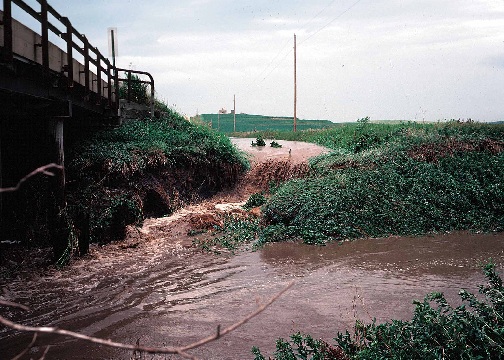Competency Area 5: Soil conservation AEM
PO 40. Understand the main agronomic and environmental consequences of soil erosion and sedimentation.
Agronomic:
- Organic-matter rich surface soil is removed.
- Nitrogen, phosphorus, potassium, and other nutrients in mineral and organic form are lost from the field.
- Herbicides and other pesticides attached to soil particles will be removed from the field.
- Since silt particles are preferentially removed in erosion, the soil tends to either become more clayey or more sandy.
- Soil depth is reduced, leading to reduced root volume and increased moisture stress.
- Rill and gully formation will compromise field work.
- Deposition can cause newly planted crops to be lost.

Runoff from farm fields reaches a sediment-laden stream
Photo courtesy of NRCS
http://photogallery.nrcs.usda.gov
Environmental:
- Increased need for channel dredging.
- Adverse impacts on the recovery of underwater grass beds because the sediment reduces the amount of light reaching plants.
- Benthic (bottom-dwelling) organisms suffer increased mortality and reduced reproduction.
- Fish may be affected as increased sediment affects their feeding, clogs gill tissues, and smothers eggs.
- Siltation can alter the habitat of aquatic organisms.
- Increased turbidity may change the abundance of plankton, a prey which is important for larval and juvenile fish.
- Phosphorus is carried with the sediment, contributing to eutrophication.
Quick Links
- Competency Area 1: Basic soil properties
- Competency Area 2: Soil hydrology AEM
- Competency Area 3: Drainage and irrigation AEM
- Competency Area 4: Soil health and compaction
- Competency Area 5: Soil conservation AEM
- Competency Area 6: Watershed hydrology AEM
- Competency Area 7: Non-point source pollution AEM
- Competency Area 8: Concentrated source pollution AEM
- Competency Area 9: Conservation planning AEM
